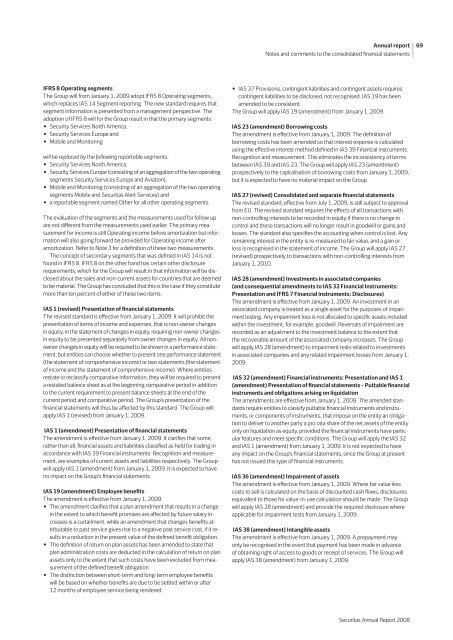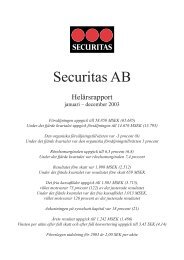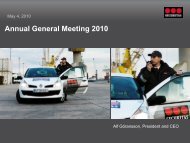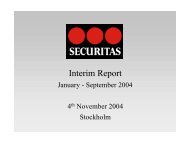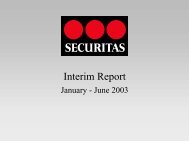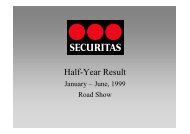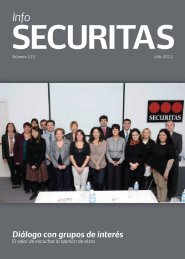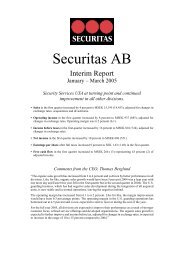Annual Report 2008 - Securitas
Annual Report 2008 - Securitas
Annual Report 2008 - Securitas
Create successful ePaper yourself
Turn your PDF publications into a flip-book with our unique Google optimized e-Paper software.
IFRS 8 Operating segments<br />
The Group will from January 1, 2009 adopt IFrS 8 Operating segments,<br />
which replaces IAS 14 Segment reporting. The new standard requires that<br />
segment information is presented from a management perspective. The<br />
adoption of IFRS 8 will for the Group result in that the primary segments:<br />
• Security Services North America,<br />
• Security Services Europe and<br />
• Mobile and Monitoring<br />
will be replaced by the following reportable segments:<br />
• Security Services North America,<br />
• Security Services Europe (consisting of an aggregation of the two operating<br />
segments Security Services Europe and Aviation),<br />
• Mobile and Monitoring (consisting of an aggregation of the two operating<br />
segments Mobile and <strong>Securitas</strong> Alert Services) and<br />
• a reportable segment named Other for all other operating segments.<br />
The evaluation of the segments and the measurements used for follow up<br />
are not different from the measurements used earlier. The primary measurement<br />
for income is still Operating income before amortization but information<br />
will also going forward be provided for Operating income after<br />
amortization. Refer to Note 3 for a definition of these two measurements.<br />
The concept of secondary segments that was defined in IAS 14 is not<br />
found in IFrS 8. IFrS 8 on the other hand has certain other disclosure<br />
requirements, which for the Group will result in that information will be disclosed<br />
about the sales and non-current assets for countries that are deemed<br />
to be material. The Group has concluded that this is the case if they constitute<br />
more than ten percent of either of these two items.<br />
IAS 1 (revised) Presentation of financial statements<br />
The revised standard is effective from January 1, 2009. It will prohibit the<br />
presentation of items of income and expenses, that is non-owner changes<br />
in equity, in the statement of changes in equity, requiring non-owner changes<br />
in equity to be presented separately from owner changes in equity. All nonowner<br />
changes in equity will be required to be shown in a performance statement,<br />
but entities can choose whether to present one performance statement<br />
(the statement of comprehensive income) or two statements (the statement<br />
of income and the statement of comprehensive income). where entities<br />
restate or reclassify comparative information, they will be required to present<br />
a restated balance sheet as at the beginning comparative period in addition<br />
to the current requirement to present balance sheets at the end of the<br />
current period and comparative period. The Group’s presentation of the<br />
financial statements will thus be affected by this standard. The Group will<br />
apply IAS 1 (revised) from January 1, 2009.<br />
IAS 1 (amendment) Presentation of financial statements<br />
The amendment is effective from January 1, 2009. It clarifies that some,<br />
rather than all, financial assets and liabilities classified as held for trading in<br />
accordance with IAS 39 Financial instruments: Recognition and measurement,<br />
are examples of current assets and liabilities respectively. The Group<br />
will apply IAS 1 (amendment) from January 1, 2009. It is expected to have<br />
no impact on the Group’s financial statements.<br />
IAS 19 (amendment) Employee benefits<br />
The amendment is effective from January 1, 2009.<br />
• The amendment clarifies that a plan amendment that results in a change<br />
in the extent to which benefit promises are affected by future salary increases<br />
is a curtailment, while an amendment that changes benefits attributable<br />
to past service gives rise to a negative past service cost, if it results<br />
in a reduction in the present value of the defined benefit obligation.<br />
• The definition of return on plan assets has been amended to state that<br />
plan administration costs are deducted in the calculation of return on plan<br />
assets only to the extent that such costs have been excluded from measurement<br />
of the defined benefit obligation.<br />
• The distinction between short-term and long-term employee benefits<br />
will be based on whether benefits are due to be settled within or after<br />
12 months of employee service being rendered.<br />
<strong>Annual</strong> report<br />
Notes and comments to the consolidated financial statements<br />
• IAS 37 Provisions, contingent liabilities and contingent assets requires<br />
contingent liabilities to be disclosed, not recognised. IAS 19 has been<br />
amended to be consistent.<br />
The Group will apply IAS 19 (amendment) from January 1, 2009.<br />
IAS 23 (amendment) Borrowing costs<br />
The amendment is effective from January 1, 2009. The definition of<br />
borrowing costs has been amended so that interest expense is calculated<br />
using the effective interest method defined in IAS 39 Financial instruments:<br />
recognition and measurement. This eliminates the inconsistency of terms<br />
between IAS 39 and IAS 23. The Group will apply IAS 23 (amendment)<br />
prospectively to the capitalisation of borrowing costs from January 1, 2009,<br />
but it is expected to have no material impact on the Group.<br />
IAS 27 (revised) Consolidated and separate financial statements<br />
The revised standard, effective from July 1, 2009, is still subject to approval<br />
from EU. The revised standard requires the effects of all transactions with<br />
non-controlling interests to be recorded in equity if there is no change in<br />
control and these transactions will no longer result in goodwill or gains and<br />
losses. The standard also specifies the accounting when control is lost. Any<br />
remaining interest in the entity is re-measured to fair value, and a gain or<br />
loss is recognised in the statement of income. The Group will apply IAS 27<br />
(revised) prospectively to transactions with non-controlling interests from<br />
January 1, 2010.<br />
IAS 28 (amendment) Investments in associated companies<br />
(and consequential amendments to IAS 32 Financial Instruments:<br />
Presentation and IFRS 7 Financial instruments: Disclosures)<br />
The amendment is effective from January 1, 2009. An investment in an<br />
associated company is treated as a single asset for the purposes of impairment<br />
testing. Any impairment loss is not allocated to specific assets included<br />
within the investment, for example, goodwill. reversals of impairment are<br />
recorded as an adjustment to the investment balance to the extent that<br />
the recoverable amount of the associated company increases. The Group<br />
will apply IAS 28 (amendment) to impairment tests related to investments<br />
in associated companies and any related impairment losses from January 1,<br />
2009.<br />
IAS 32 (amendment) Financial instruments: Presentation and IAS 1<br />
(amendment) Presentation of financial statements – Puttable financial<br />
instruments and obligations arising on liquidation<br />
The amendments are effective from January 1, 2009. The amended standards<br />
require entities to classify puttable financial instruments and instruments,<br />
or components of instruments, that impose on the entity an obligation<br />
to deliver to another party a pro rata share of the net assets of the entity<br />
only on liquidation as equity, provided the financial instruments have particular<br />
features and meet specific conditions. The Group will apply the IAS 32<br />
and IAS 1 (amendment) from January 1, 2009. It is not expected to have<br />
any impact on the Group’s financial statements, since the Group at present<br />
has not issued this type of financial instruments.<br />
IAS 36 (amendment) Impairment of assets<br />
The amendment is effective from January 1, 2009. Where fair value less<br />
costs to sell is calculated on the basis of discounted cash flows, disclosures<br />
equivalent to those for value-in-use calculation should be made. The Group<br />
will apply IAS 28 (amendment) and provide the required disclosure where<br />
applicable for impairment tests from January 1, 2009.<br />
IAS 38 (amendment) Intangible assets<br />
The amendment is effective from January 1, 2009. A prepayment may<br />
only be recognised in the event that payment has been made in advance<br />
of obtaining right of access to goods or receipt of services. The Group will<br />
apply IAS 38 (amendment) from January 1, 2009.<br />
<strong>Securitas</strong> <strong>Annual</strong> report <strong>2008</strong><br />
69


